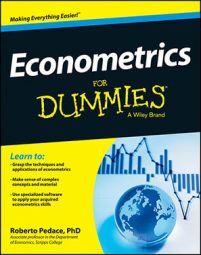Economists apply econometric tools in a variety of specific fields (such as labor economics, development economics, health economics, and finance) to shed light on theoretical questions. They also use these tools to inform public policy debates, make business decisions, and forecast future events.
Following is a list of ten interesting, practical applications of econometric techniques.
Forecasting macroeconomic indicators: Some macroeconomists are concerned with the expected effects of monetary and fiscal policy on the aggregate performance of the economy. Time-series models can be used to make predictions about these economic indicators.
Estimating the impact of immigration on native workers: Immigration increases the supply of workers, so standard economic theory predicts that equilibrium wages will decrease for all workers. However, since immigration can also have positive demand effects, econometric estimates are necessary to determine the net impact of immigration in the labor market.
Identifying the factors that affect a firm's entry and exit into a market: The microeconomic field of industrial organization, among many issues of interest, is concerned with firm concentration and market power. Theory suggests that many factors, including existing profit levels, fixed costs associated with entry/exit, and government regulations can influence market structure. Econometric estimation helps determine which factors are the most important for firm entry and exit.
Determining the influence of minimum-wage laws on employment levels: The minimum wage is an example of a price floor, so higher minimum wages are supposed to create a surplus of labor (higher levels of unemployment). However, the impact of price floors like the minimum wage depends on the shapes of the demand and supply curves. Therefore, labor economists use econometric techniques to estimate the actual effect of such policies.
Finding the relationship between management techniques and worker productivity: The use of high-performance work practices (such as worker autonomy, flexible work schedules, and other policies designed to keep workers happy) has become more popular among managers. At some point, however, the cost of implementing these policies can exceed the productivity benefits. Econometric models can be used to determine which policies lead to the highest returns and improve managerial efficiency.
Measuring the association between insurance coverage and individual health outcomes: One of the arguments for increasing the availability (and affordability) of medical insurance coverage is that it should improve health outcomes and reduce overall medical expenditures. Health economists may use econometric models with aggregate data (from countries) on medical coverage rates and health outcomes or use individual-level data with qualitative measures of insurance coverage and health status.
Deriving the effect of dividend announcements on stock market prices and investor behavior: Dividends represent the distribution of company profits to its shareholders. Sometimes the announcement of a dividend payment can be viewed as good news when shareholders seek investment income, but sometimes they can be viewed as bad news when shareholders prefer reinvestment of firm profits through retained earnings. The net effect of dividend announcements can be estimated using econometric models and data of investor behavior.
Predicting revenue increases in response to a marketing campaign: The field of marketing has become increasingly dependent on empirical methods. A marketing or sales manager may want to determine the relationship between marketing efforts and sales. How much additional revenue is generated from an additional dollar spent on advertising? Which type of advertising (radio, TV, newspaper, and so on) yields the largest impact on sales? These types of questions can be addressed with econometric techniques.
Calculating the impact of a firm's tax credits on R&D expenditure: Tax credits for research and development (R&D) are designed to provide an incentive for firms to engage in activities related to product innovation and quality improvement. Econometric estimates can be used to determine how changes in the tax credits influence R&D expenditure and how distributional effects may produce tax-credit effects that vary by firm size.
Estimating the impact of cap-and-trade policies on pollution levels: Environmental economists have discovered that combining legal limits on emissions with the creation of a market that allows firms to purchase the "right to pollute" can reduce overall pollution levels. Econometric models can be used to determine the most efficient combination of state regulations, pollution permits, and taxes to improve environmental conditions and minimize the impact on firms.

